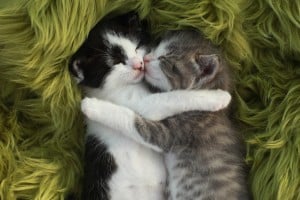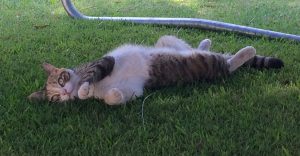Domestic cats are a wonderful species that have been living close to and with humans for thousands of years. They were revered in Ancient Egypt… and still are in many homes where their faithful human servants attend to them. Jokes aside, cats are fascinating and are incredibly well adapted to living with us. However, as humans, we often make the error of thinking of them as ‘small furry people’ or ‘little meowing dogs’ – big mistake!
What makes cats different?
Cats interact in a different way from dogs and people. During the breeding season, feral cats will live together in groups of related adult females (mothers & daughters), where they can provide for and defend their kittens. Close physical contact is often seen between kittens and the adult females, however as they grow and become more mature, these interactions may become less frequent and change in expression. Adult male cats are usually at the periphery of the group with one tom usually breeding the majority of females in his territory and other males being rejected from the area. The focus is aimed at survival by protecting resources such as food, water, shelter etc. with outsiders or ‘strangers’ seen as competition for those resources. Members in the group will display hostile behaviours towards ‘strangers’ so as to protect their access to the resources. These hostile behaviours are designed to keep the ‘strangers’ far away i.e. urine marking, body language and vocalising.
However, if a ‘stranger’ has not heeded these warning signals and they come into close proximity, the physical interactions can be intensely aggressive. Within a stable social group however, physical conflict is rare and most communication is by body language which is designed to avoid the risk of injury.
As adults outside of the mating season, cats are generally solitary animals with self-preservation of utmost importance. They spend most of their time on their own, doing their own thing and without an instinctual need for social cooperative behaviours as occurs in other species like humans and dogs. As humans, we generally don’t survive so well on our own… This simple fact goes a long way to explaining why cats behave the way they do – they do not rely on social interactions for their survival; they’re ‘nice-to-haves’ rather than ‘must-haves’ for cats. It also means that they have fewer “making friends” behaviours than other socially obligate species, like dogs, do. In other words, cats can be quite happy spending a limited amount of time with a select few people or fur friends and generally do not feel the need to be in constant social contact with other creatures.
But what about my cat? I’m sure she enjoys cuddles.
Having discussed the general tendencies of most cats, there are definitely variations in the sociability between individuals. Some individuals have a very low requirement for social interactions – these may be kitties that spend a lot of time out in the garden, come in for a meal and then disappear again only to be seen at the next meal. Others have a higher requirement for social interactions and these individuals may be better suited to living in a domestic environment. There are also ways in which we can influence this tendency in more sociable cats by the way we raise kittens. It has been scientifically proven that appropriate handling of kittens between 3 and 7 weeks old, when they are in a positive emotional state, certainly makes them more amenable and comfortable with our human desire for close contact and cuddles. This means that socialised kittens are more likely to learn that human behaviours are not threatening and accept them as normal. Even so, these cats will still prefer low intensity high frequency interactions e.g. regularly walking passed an owner doing a little ‘meow’ is characteristic of a friendly feline social interaction. On the other hand, humans tend to have high intensity, low frequency interactions e.g. one long cuddle a day. This means that as cat owners, we need to be realistic about what we can expect from our interactions with our cats as well as the cat’s interactions with other people and animals in the household.
What does this mean for living in the “real world” with pet cats?
Because of cats’ solitary natures, they can be quite secretive about their eating, grooming and toiletting habits. For kitties there is no fun in going to the toilet in a group like a bunch of teenage kids. Nor do they want to ‘sit around the dinner table’ and share a meal. And cleaning themselves? That is most definitely a private affair! Here are a few guidelines that you can use at home to assist in setting up your space so that it is indeed kitty friendly:
- Provide enough litter trays in various locations of your home in order to cater for the number of cats. A general rule of thumb is: the number of cats + 1. So if you have 2 cats, you should have a minimum of 3 litter trays. This is important: no-one likes to stand in-line every single time one needs to go to the loo! Remember: It does not help to have 3 litter trays in 1 room either – to a cat that just counts as 1 BIG litter tray. They need to be in different locations to allow for the “privacy” factor. And always clean trays frequently – no-one likes using a stinky loo either.
- Provide separate food bowls for each cat and in different areas of the home. Once again, cats don’t view eating as a sociable experience like we do. In fact, to a cat, having a crowd around whilst eating is a cause for anxiety – “Is someone else going to want to get my food?” So, place bowls of food in quieter areas where cats can eat in peace without having to worry about when they’re going to be interrupted.
- Provide separate water bowls AWAY from food bowls. Cats do not eat and drink at the same sitting like people do. Their natural behaviours are to eat in one area and drink in another. So don’t use a combination food and water bowl either because your kitty is unlikely to drink enough water to satisfy its requirements. Using plastic bowls may also ‘taint’ the water so cats may also not drink as much because they don’t like the flavour. Consider changing to glass or ceramic. Other cats are fans of ‘running water’ so it may be worthwhile considering investing in a water fountain. And as with food bowls, ensure there are several around in different areas.
- Provide various options for rest and relaxation. Imagine trying to sleep in a chair at a busy side walk cafe where people are chatting, joking, dancing and carrying on. The equivalent for a cat would be putting their bed on the floor in the kitchen where everyone rushes about all day – not very restful. Cats are most comfortable sleeping in elevated, sheltered positions e.g. on the top shelf of a cabinet; on the chair in the study; in a basket on the shelf in the laundry. Providing quiet little hidey-holes does not need to be expensive either – a little cardboard box lined with a blanket and tipped on its side, placed in a quiet spot is most attractive to a kitty.
- Providing opportunities for your cat to be on its own. Do not expect your cat to want to join in the Saturday night footy-club festivities. He will be far more appreciative of the chance to hide away from all the noise and ‘strangers’ in the house. Also, if you’re considering adopting a new fur member, be realistic about your expectations. Do not expect that your present cat will automatically love the new kitten or puppy. Expect that he will take a while to get used to a new individual being on the scene and that they may never be best friends. It sometimes helps to think about it from the perspective that they are “neighbours living in the same apartment block” – ensure that there is easy access to all the necessities for both individuals ensuring that the possibility of tensions flaring up is reduced.
How do you know when things are going wrong?
By understanding how cats interact with each other, us and other species, we are able to provide them with options where they can express their normal behaviours and have a high quality of life. Sometimes though, it can be difficult to understand what cats are trying to tell us (or somebody else!) This list (by no means exhaustive) offers some clues that you and your cat may need some help:
- Urine marking or spraying in the house
- Cat fight wounds
- Excessive grooming
- One cat is over-eating and another is losing weight
- Changes in sleeping habits
- Soiling outside the litter tray
- Reluctance to spend time in areas where he/she used to spend a lot of time
- Changes in the amount that your cat interacts with you or other family members.
The causes for these changes may be medical, environmental, social or behavioural. Do not ignore these signs – they are like little bells that should alert you that there may be an issue. This is also the point where you should definitely discuss your concerns with your vet.
If you do have concerns about your cat’s behaviour or just need some advice about how to best set up for a happy cat, please give us a call on 0481 527 678 or email to book an appointment. We’re looking forward to meeting you both!


